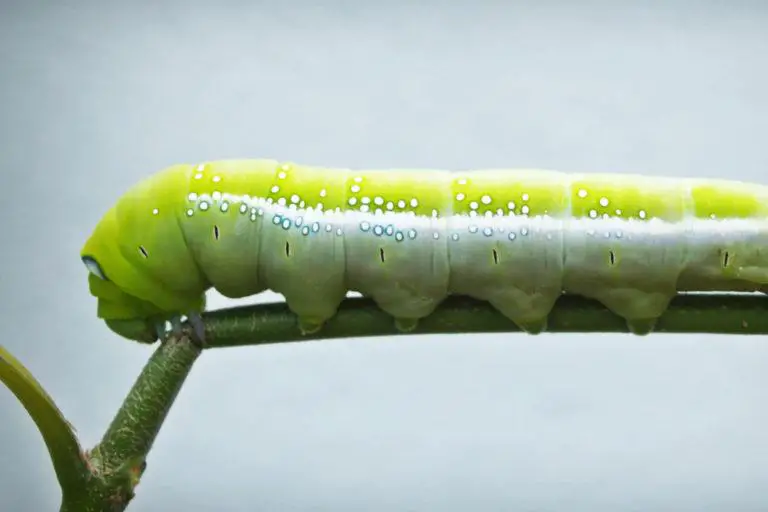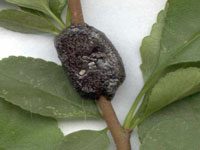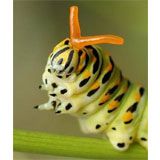
As a child, I was fascinated by caterpillars (and I guess I still am). My brothers and I would tromp around the yard and the neighboring woods in the spring, mason jars in hand, and scour the foliage for caterpillars. Of course we had our mason jars stuffed with fun things for our captured caterpillars to do. There would be some nice grass in the bottom, a few leaves so the caterpillar would have a little something to snack on, and the obligatory stick for the little guy to crawl up on. It was excellent. And then after a couple days of captivity, if the caterpillar was still alive, we would usually tire of it and either use it as fish bait or spend some quality time with it and a magnifying glass.
As it turns out, I think that’s what my dad was hoping we would do with them. Actually, I think he wished we would have killed a lot more of them than we did. Once you realize just how destructive caterpillars can be, they sorta lose their magic. They can, and often do, destroy your vegetables like cabbage and tomatoes. They also like to munch on those fresh herbs you’ve been growing, and they might even enjoy some of your prized flowers for dessert.
If tent caterpillars are your enemy (you know, the ones that spin and live in a huge web mass in your trees), they can, in extreme cases, completely defoliate a tree. In this article, my primary focus will be on how to get rid of tent caterpillars. However, many of the suggestions, especially the ones at the bottom of this page, will work very well for getting rid of caterpillars of any flavor.
Best Tent Caterpillar Control Methods
Bacillus thuringiensis.
Say what? Yeah, let’s just call it BT. This is simply the number one thing you can do to get rid of caterpillars. It is a bacteria that infects and kills caterpillars by destroying the lining of their guts. The great thing is it only kills caterpillars, which means there are no innocent bystanders that get wasted in the process. Since BT must be ingested to work, it is applied to foliage as a spray. BT is available online or at any garden shop. Make sure to get BTK. The “K” stands for kurstaki. You can get Bacillus Thuringiensis from Amazon for a good price.

Find a good long stick.
Maybe the most common way to get rid of caterpillar nests is to simply use a long stick to scrape the thing out. Just poke the stick into the nest and start spinning and scraping. It will work much better for you if you pound a few nails into the stick. In fact, if you have one, use an old broom handle. You will want to do this in the early morning or in the late evening so you will be sure that they are in their nests. Dispose of them however you wish, though it is satisfying to burn the stick you used to scrape out the nest.
Slash and burn.
Another good method for caterpillar control is cutting down their nests and burning them. Use pruning shears, a hand saw, or a chain saw to disconnect the branches with the tent caterpillar nest on them from the rest of the tree. Pull the branches down to the ground and pick your favorite incineration method. We always used an empty aluminum garbage can, a bottle of charcoal lighter fluid, and a match. If you don’t feel like using fire, just stomp on them for awhile.
Manual caterpillar pest control.
This is another one of those methods to control caterpillars that will work for absolutely any type of pest caterpillar you find. However, I wouldn’t advise it for the squeamish. Grab yourself an empty ice cream pail, coffee can, or whatever else you can find, fill it about half way up with water, squirt about a quarter cup of dish soap in it, and start picking. Just use your fingers to pluck caterpillars off of plants and toss them into the bucket to drown. Look very carefully for them. They oftentimes hide on the undersides of leaves.

Get rid of tent caterpillar egg masses.
This is actually easier than it sounds. The egg masses of tent caterpillars are pretty easy to identify. See right. In the winter, go outside with a good sharp knife and search every tree you can see for the little egg masses. They can be on trunks or branches. When you find them, scrape them off and destroy them. You may also wish to bring a pair of shears with you, too, as sometimes it’s easier to just snip the branch off.
Other Common Caterpillars

Parsley Worms.
Parsley worms are commonly found munching on your parsley and other plants like dill, fennel, carrots, Queen Anne’s lace, and parsnips. They are know as black swallowtail butterflies as adults. See the bottom of this page for caterpillar control products.
Cutworms.
Cutworms are found frequently eating the stems of asparagus, cabbage, carrots, corn, and tomatoes, to name a few. They are the larvae of night-flying moths of the Noctuidae family. Check out the bottom section of this article for products for controlling caterpillars.
Gypsy Moth Caterpillars.
Gypsy moth caterpillars are found most commonly in and dangling from trees and shrubs. They eat foliage primarily at night but can be seen during the day. See the bottom section of this page for some products to help you get rid of caterpillars.
Caterpillar Control Products
While I do feel strongly that BTK (mentioned above) is the best thing you can use to get rid of caterpillars, there are many other types of caterpillar pest control products available that work very well for almost any type of caterpillar. Neem oil is one of these. It is a natural oil derived from the neem tree that not only can be used as an insecticidal soap to kill caterpillars immediately, but it also tastes so bad that when sprayed on things caterpillars eat, they would rather starve than ingest anything sprayed with it.
Pyrethrins are another common and effective way to get rid of caterpillars. We write about pyrethrins in our piece on how to get rid of maggots, and several other how-to guides. They are generally found in spray form. Look for brands like Take Down and Rotenone-Pyrethrin Spray. Insecticidal soaps are another way to go. These work not only by dissolving the protective layer, or “cuticle,” of insects, they also destroy cell membranes causing cell contents to spill out. Look for brands like Safer Insecticidal Soap (which you can get at Amazon) and Garden Safe. Be careful using pyrethrins, and use them sparingly. They kill bees, and we do not advocate killing bees.
Many people take a preventative approach and spray their trees with dormant oil in the winter or early fall. This is a thick, plant-based oil that, when sprayed liberally on trees, engulfs and suffocates the insects that are lying dormant in the bark. Look for brands like Eco-Oil and All Seasons Horticultural & Dormant Spray Oil. One last thought: if you don’t feel like spraying anything or you are looking for something to use in addition to your spray, use a trunk band. Using duct tape or aluminum foil, construct a band around the trunk of the tree, and coat it with something sticky like petroleum jelly or, better yet, Tree Tanglefoot Pest Barrier.
Best Organic Caterpillar Control
Birds.
Many birds are happy to eat caterpillars, so do whatever you can to attract more birds to your yard. Put up feeders, houses, nesting shelves, and birdbaths. It’s also a good idea to get yourself some chickens. They’ll nab and eat pretty much anything that moves. Also, hey! Eggs!

Paper Wasps.
Generally speaking, if you leave paper wasps alone, they’ll leave you alone. Unless you’re too scared or someone in you family is allergic, permit paper wasps to set up shop in your yard. Turns out they are quite happy to eat soft-bodied insects like caterpillars.
Burlap bags.
You can kill lots of gypsy moth caterpillars simply by wrapping your tree trunks with a band of burlap bags. Since these caterpillars like to hide during the heat of the day, they will find their way into and under the burlap bags, making it very easy for you to kill lots of them quickly.